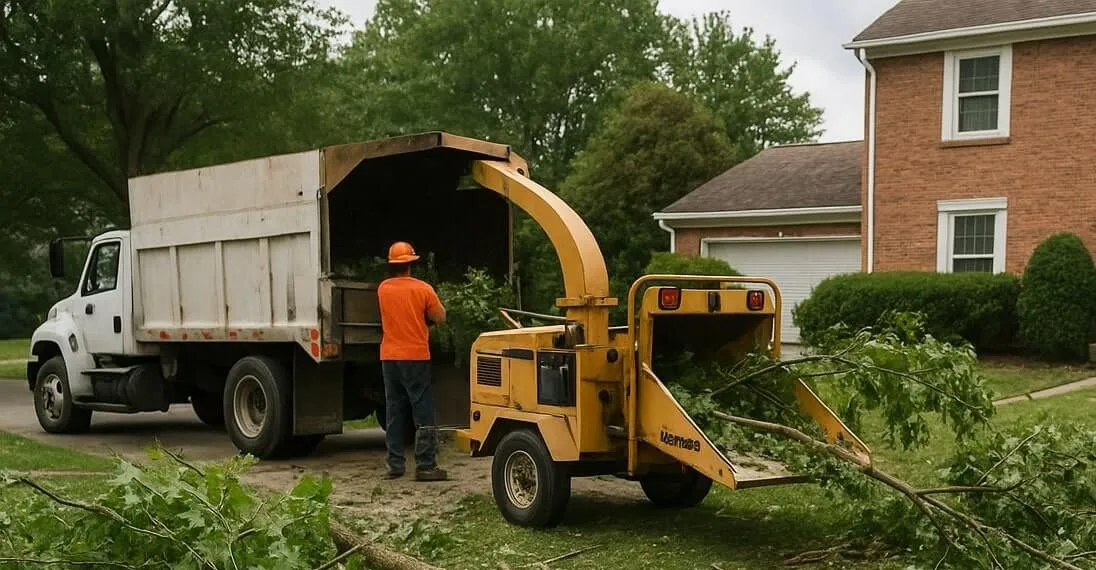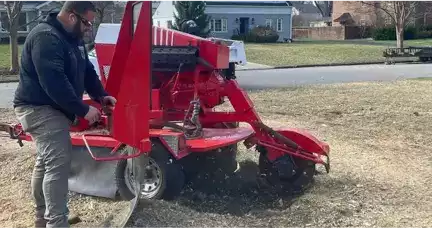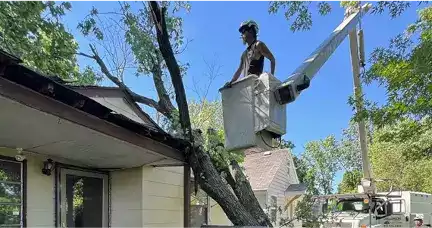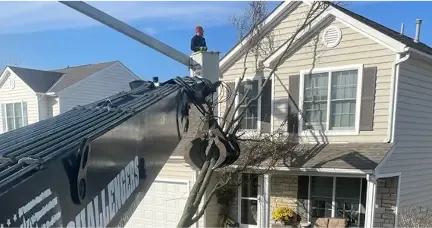It’s 2 AM, and you’re startled awake by a thunderous crash that shakes your entire home. The severe thunderstorm that’s been raging across Columbus for hours has just sent a massive oak tree crashing through your roof. Rain is pouring in, your children are terrified, and you have no idea what to do next. If you’re frantically searching for “emergency tree service near me” in Columbus at this moment, you’re not alone.
Tree emergencies don’t wait for convenient times. They strike suddenly- during violent summer thunderstorms that sweep across Grove City, during winter ice events that overwhelm branches in Dublin neighborhoods, or during those unexpected windstorms that seem to target the mature trees in established Worthington communities. The combination of Central Ohio’s clay-heavy soil, seasonal weather extremes, and our region’s abundant tree canopy creates perfect conditions for tree failures that can threaten your family’s safety and damage your most valuable asset: your home.
What Qualifies as a Tree Emergency in Columbus?
Not every fallen branch constitutes an emergency, but certain situations require immediate professional attention. Here’s how to determine if your situation qualifies as a true tree emergency:
Trees on Structures
When a tree falls on your home, garage, or other structure, it creates an immediate hazard. The weight of the tree can compromise structural integrity, and any delay in removal could lead to additional damage, especially if rain is entering through damaged roofing. This scenario requires immediate professional attention.
Trees Blocking Access
Trees that have fallen across driveways, entrances, or roadways create accessibility problems that may need urgent attention, particularly if they’re preventing emergency vehicles from reaching your property or trapping vehicles that need to exit.
Trees on Power Lines
One of the most dangerous scenarios occurs when trees or large limbs land on power lines. This creates both an electrical hazard and a potential fire risk. Never attempt to remove these yourself- contact both your utility provider and an emergency tree service immediately.
Leaning Trees After Storms
Following Columbus’s severe summer thunderstorms or winter ice events, trees sometimes remain standing but develop a dangerous lean. If you notice a tree suddenly leaning toward structures or high-traffic areas, especially with visible root lifting, this requires urgent assessment and potential removal.
Split Trunks or Major Limb Failure
Trees with split trunks or major limbs that have partially broken but remain attached (known as “hangers”) present unpredictable falling hazards. These situations often worsen with time or additional weather changes and should be addressed promptly.
What to Do When You Have a Tree Emergency in Columbus
When facing a tree emergency, taking the right immediate steps can prevent further damage and ensure everyone’s safety:
1. Ensure Personal Safety First
If a tree has fallen or is threatening to fall, evacuate the area immediately. Keep family members, pets, and neighbors away from the danger zone. Your safety is the top priority.
2. Check for Power Line Involvement
If power lines are affected, call the local utility company immediately. In Columbus, you should contact AEP Ohio at their emergency number. Do not approach downed lines under any circumstances- even professionals won’t begin work until utility companies have addressed electrical hazards.
3. Document the Damage
If it’s safe to do so, take photos of the situation from multiple angles. This documentation will be valuable for insurance claims and will help emergency tree services understand the scope of the problem when you call.
4. Contact Your Insurance Company
Many homeowner policies cover emergency tree removal, especially when structures are damaged. Contact your insurance provider as soon as possible to report the incident and understand your coverage.
5. Call for Professional Emergency Tree Removal
Contact a reputable emergency tree service like Challengers Tree Service that offers 24/7 response throughout Columbus and surrounding areas. Describe the situation in detail so they can bring the appropriate equipment and crew.
Securing the Area
The crew will establish a safety perimeter around the work zone. This might involve:
- Setting up caution tape or barriers
- Clearing the area of people and pets
- Positioning vehicles and equipment strategically
- Protecting surrounding property features that aren’t damaged
Coordinated Removal Strategy
Emergency tree removal in Columbus often requires a strategic approach- especially in densely populated neighborhoods like Clintonville or German Village where properties are close together. Professionals will:
- Remove the tree in sections rather than all at once
- Use specialized rigging techniques to control each piece
- Work from top to bottom, addressing the most dangerous portions first
- Coordinate with utility companies if power lines are involved
Immediate Hazard Clearing
The primary goal of emergency tree services is to eliminate the immediate danger. This means they will:
- Remove the tree from structures
- Clear blocked access points
- Eliminate hanging or unstable portions
- Make the area safe
While complete cleanup might follow later, the initial emergency response focuses on addressing the hazardous situation first.
Common Tree Emergencies in Columbus by Season
Columbus experiences distinct seasonal weather patterns that create different types of tree emergencies throughout the year:
Summer Storm Emergencies (May-September)
Summer brings powerful thunderstorms that can generate straight-line winds exceeding 70 mph. These sudden, intense storms often cause:
- Healthy trees to uproot in saturated soil, particularly in areas like Dublin and Worthington with their clay-heavy ground
- Large limbs to break from otherwise healthy trees
- Multiple tree failures across neighborhoods during severe systems
The combination of full summer foliage (which catches wind like a sail) and occasional saturated ground creates perfect conditions for tree failures.
Winter Weather Emergencies (December-March)
Central Ohio’s winter storms bring different challenges:
- Ice accumulation adds tremendous weight to branches, causing breakage
- Snow-loaded branches can snap suddenly
- Freeze-thaw cycles weaken already compromised trees
- Multiple freeze-thaw cycles in Columbus’s fluctuating winter temperatures can damage tree structures
Neighborhoods with mature tree canopies like Upper Arlington and Bexley are particularly vulnerable to winter tree emergencies.
Spring Wind and Rain Events (March-May)
Early spring brings its own tree hazards:
- Trees leafing out during spring storms catch more wind
- Saturated spring soil provides less root stability
- Trees weakened by winter damage may fail during spring storms
Fall Wind Events (October-November)
As leaves drop and fall storms arrive:
- Trees weakened throughout the growing season may fail
- Late-season storms can be particularly damaging
- Root diseases that developed during summer often lead to fall tree failures
The Cost of Emergency Tree Services in Columbus
Emergency tree services typically cost more than planned removals due to their urgent nature and often complex conditions. While specific pricing depends on your situation, these factors influence the cost:
Factors Affecting Emergency Removal Costs
- Timing: After-hours, weekend, or holiday emergency service may incur higher rates
- Complexity: Trees on structures or involving power lines require more time and expertise
- Size and Location: Larger trees or those in difficult access positions cost more to remove
- Equipment Needed: If a crane or other specialized equipment is required, this affects pricing
- Number of Trees: Multiple failures from the same storm may be handled as a single emergency job
- Additional Services: Immediate cleanup, tarp installation for damaged roofs, or stump removal add cost
Comparing Emergency vs. Standard Tree Removal
Understanding the differences between emergency and standard tree removal can help you make informed decisions:
| Aspect | Emergency Tree Removal | Standard Tree Removal |
|---|---|---|
| Response Time | Typically within 1–3 hours | Scheduled days or weeks in advance |
| Work Conditions | Often during/after storms, potentially hazardous | Planned during ideal weather and daylight |
| Risk Level | Higher due to unstable trees, potential structural damage | Lower with controlled environment and planning |
| Crew Size | Usually larger crews to handle urgent situations quickly | Standard crew size appropriate for the job |
| Equipment | May require specialized emergency equipment like cranes | Standard equipment planned in advance |
| Cost Factors | Premium for urgent service, after-hours work, hazardous conditions | Base rates without emergency premiums |
| Priority | Addressing immediate dangers and preventing further damage | Complete removal with thorough cleanup |
| Insurance | Often covered by homeowner’s insurance when structures are damaged | Typically not covered by insurance |
| Planning | Minimal pre-planning; immediate response required | Thorough assessment; permits obtained if needed |
| Cleanup | Initial focus on removing hazards; complete cleanup may follow later | Complete cleanup included in service |
Insurance Coverage for Emergency Tree Service
Many homeowner insurance policies cover emergency tree removal when:
- The tree has damaged an insured structure (house, garage, fence)
- The tree is blocking access to your home
- The tree fell due to a covered peril (like a storm)
Insurance typically won’t cover:
- Removal of trees that fell without damaging anything
- Trees that fell due to pre-existing disease or neglect
- Preventative removal of dangerous trees
Always document the emergency situation thoroughly with photos and contact your insurance provider promptly to understand your coverage.
Preventing Future Tree Emergencies in Columbus
While some emergencies are unavoidable, many can be prevented with proper tree care:
Regular Professional Inspections
Have a certified arborist inspect your trees annually, particularly:
- After severe weather events
- If you notice any changes in the tree’s appearance
- For trees near structures or in high-traffic areas
- When buying a new property with mature trees
Recognize Warning Signs
Learn to spot potential problems before they become emergencies:
- Leaning trunks (especially new leans)
- Cracks in major limbs or trunks
- Mushrooms growing at the base of trees
- Dead branches, particularly large ones
- Cavities or decay in the trunk
- Lifting soil around the base indicating root failure
Common Questions About Emergency Tree Services
How quickly can an emergency tree service respond in Columbus?
Reputable emergency tree services in Columbus typically respond within 1-3 hours for true emergencies, depending on current demand and your location. During widespread storm events, response times may be longer as services prioritize the most dangerous situations first.
Will my insurance cover emergency tree removal?
Most homeowner insurance policies in Columbus cover emergency tree removal when the tree has damaged an insured structure or is blocking access to your home. The coverage typically includes removing the tree from the structure and making temporary repairs to prevent further damage. Always document the situation thoroughly with photos and contact your insurance company promptly.
Is it safe to stay in my home with a tree on the roof?
In most cases, it’s safer to evacuate until professionals can assess the situation. If a tree has punctured your roof or is applying significant pressure to your home’s structure, there could be hidden damage that compromises structural integrity. If you must remain in the home, stay in portions furthest from the affected area until professionals arrive.
How do I know if a leaning tree requires emergency removal?
Signs that a leaning tree requires emergency attention include:
- A new lean that wasn’t present before
- Visible lifting or cracking of soil around the base
- Cracking sounds coming from the trunk or root area
- The tree leans toward a structure, high-traffic area, or power lines
- The lean has visibly worsened over a short period
When in doubt, contact a professional for an immediate assessment.
What should I do if a tree falls on power lines?
If a tree falls on power lines:
- Stay at least 50 feet away from downed lines
- Call the power company immediately (AEP Ohio for most Columbus residents)
- Contact an emergency tree service that works with utility companies
- Keep everyone (including pets) away from the area
- Never attempt to remove the tree yourself, even if the power appears to be out
Remember that power lines can energize trees, making them dangerous to touch.
Can emergency tree removal be done at night?
Yes, legitimate emergency tree services operate 24/7 and have the equipment to work safely after dark. They use powerful floodlights and headlamps to illuminate the work area. However, for all but the most urgent situations (like trees on houses causing active leaks or blocking essential access), some companies may secure the area and return at first light when work can be done more safely.
Can I remove a tree near my house?
While legally you can remove trees on your own property, removing trees near houses presents significant risks that often require professional expertise:
- Trees near structures require precise directional felling or piece-by-piece removal to prevent property damage
- Falling trees behave unpredictably, especially for inexperienced individuals
- House proximity limits working space and escape routes if something goes wrong
- Root systems near foundations require careful consideration during removal
- City permits may be required in Columbus for removing trees over certain sizes
- Trees within 10 feet of power lines should never be removed by non-professionals
For safety and property protection, trees within falling distance of your home should typically be removed by certified professionals with proper insurance, equipment, and experience in technical removals.
How much does it cost to cut down a tree in Columbus, Oh?
Tree removal costs in Columbus vary widely based on several key factors rather than having standard rates. The primary considerations include:
- Tree size: Height and trunk diameter significantly impact removal complexity
- Accessibility: Trees with limited access require more labor-intensive techniques
- Species: Different tree types present varying challenges (hardwoods vs. softwoods)
- Location risk: Trees near structures, power lines, or other obstacles require specialized techniques
- Tree condition: Dead, diseased, or unstable trees often require additional safety measures
- Removal complexity: Simple felling vs. technical piece-by-piece removal
- Stump options: Whether stump grinding is included or added separately
- Cleanup requirements: Complete debris removal vs. leaving wood on property
- Season and demand: Peak periods after storms may affect pricing
- Emergency factors: Urgent removals typically command premium rates
Columbus homeowners should expect to pay more for large trees, those in difficult locations, or those requiring urgent removal. The best approach is to get a professional on-site assessment for an accurate quote based on your specific situation.
Reliable Emergency Tree Services in Columbus and Surrounding Areas
When storm damage strikes and you need emergency tree removal near you in Columbus, Grove City, Dublin, or other Central Ohio communities, Challengers Tree Service provides responsive, professional assistance. Our emergency crews are available 24/7 to address dangerous tree situations throughout the region.
With years of experience handling tree emergencies across Columbus neighborhoods, from historic German Village to newer developments in New Albany, our team brings the equipment, expertise, and local knowledge needed to resolve even the most challenging situations safely and efficiently.
Give us a call at (614) 683-2322. We’re available 24/7 for all your emergency tree removal needs throughout Columbus and nearby areas:
- Emergency Tree Service in Columbus
- Emergency Tree Service in Grove City
- Emergency Tree Service in Hilliard
- Emergency Tree Service in Dublin
- Emergency Tree Service in Powell
- Emergency Tree Service in Westerville
- Emergency Tree Service in Gahanna
- Emergency Tree Service in Reynoldsburg
- Emergency Tree Service in Blacklick
- Emergency Tree Service in Orient





